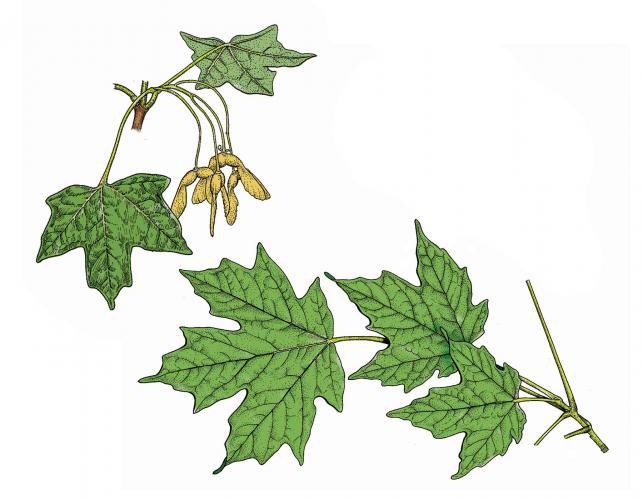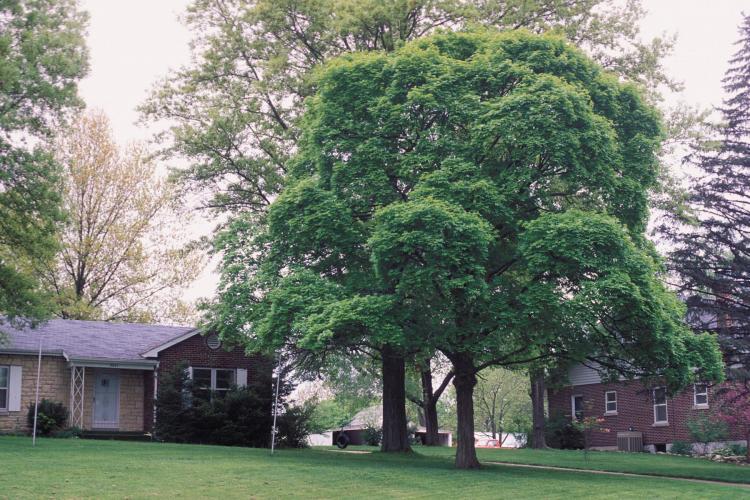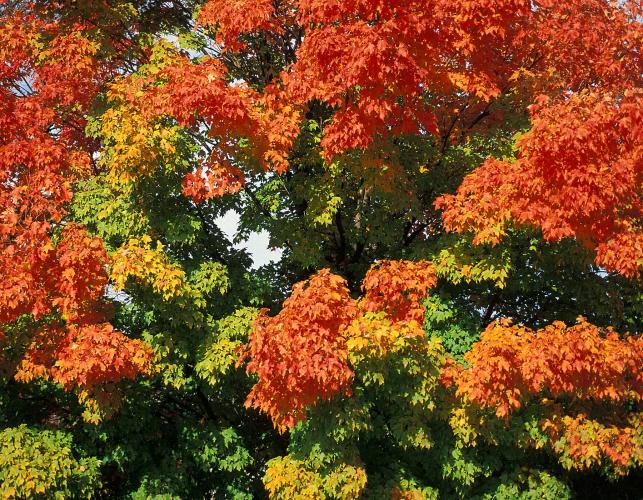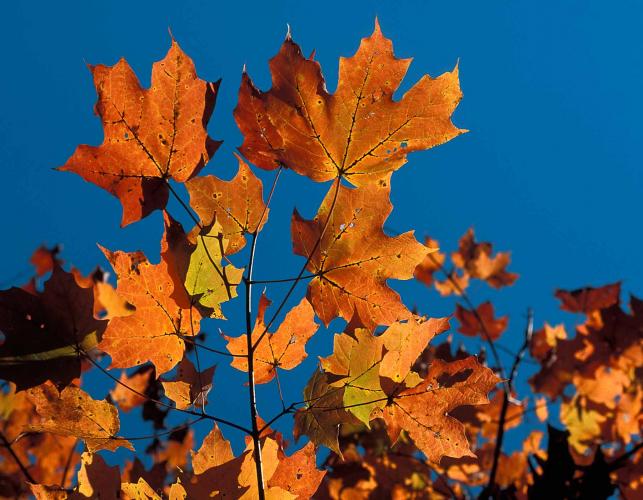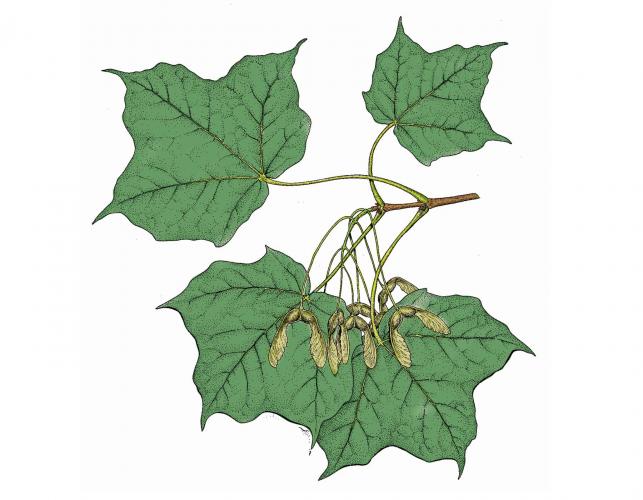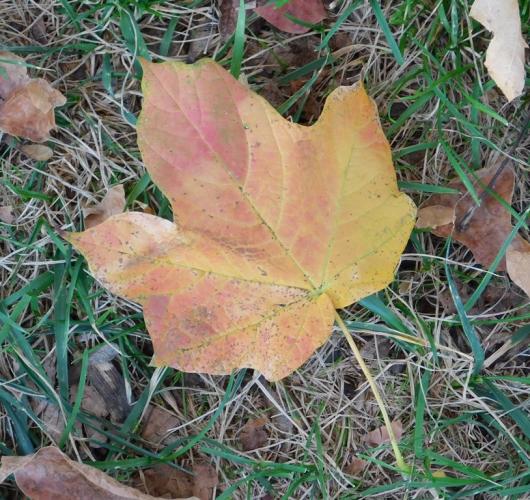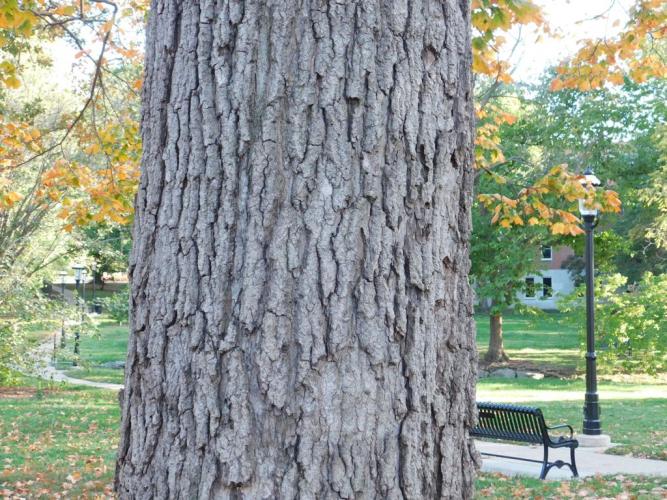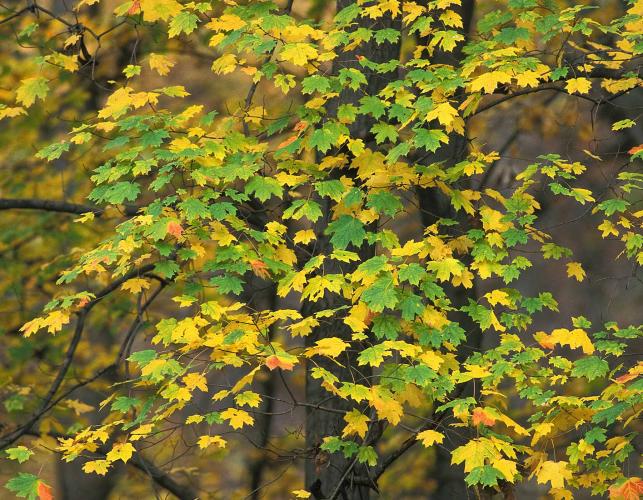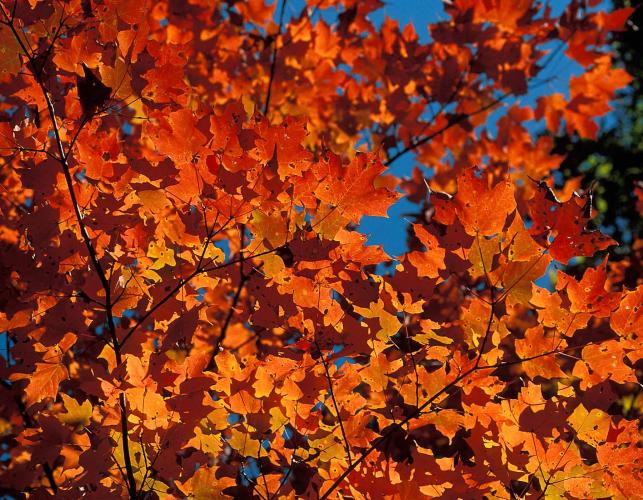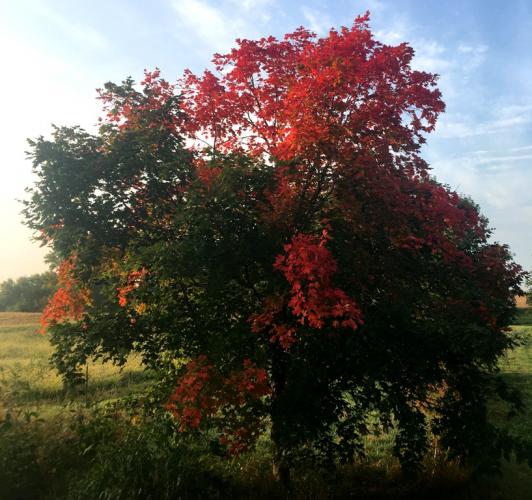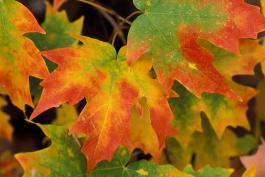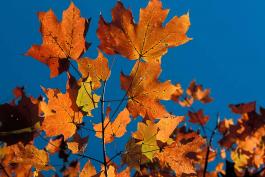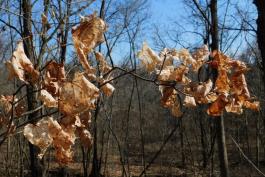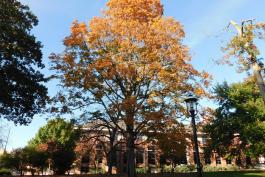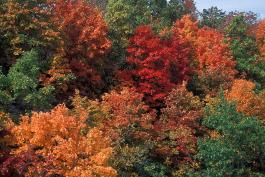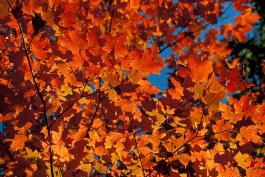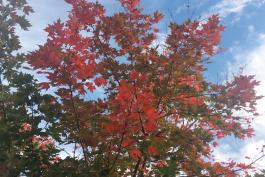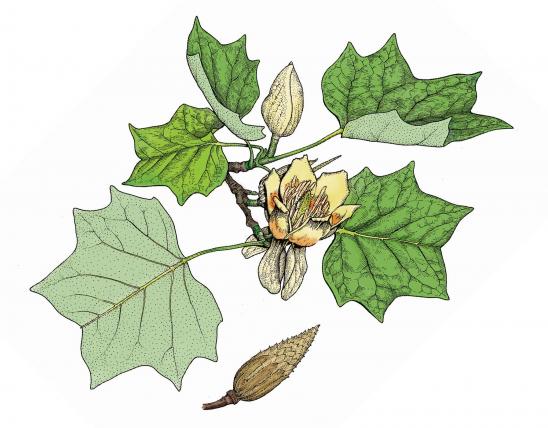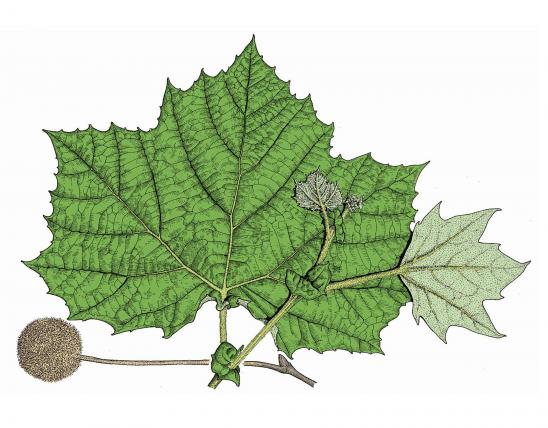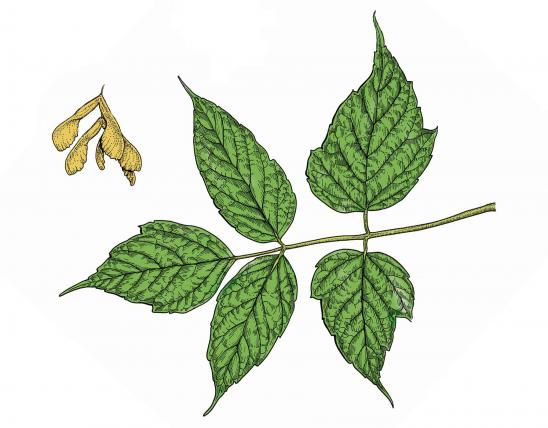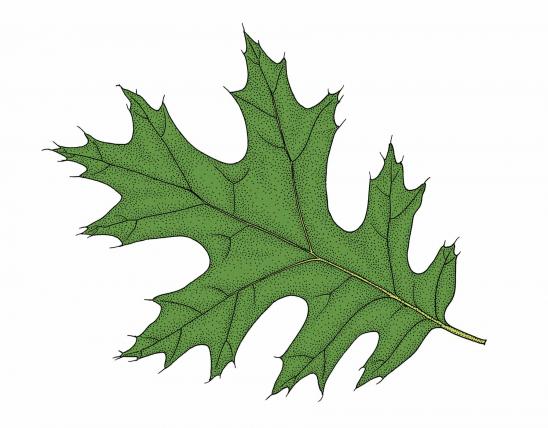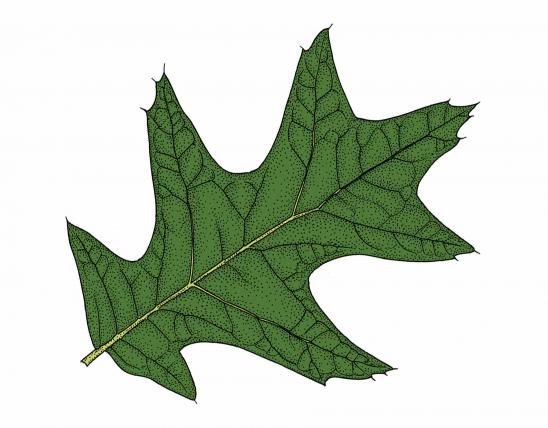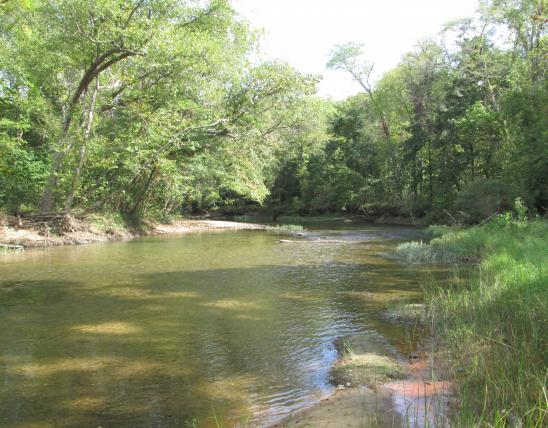
Sugar maple is a medium to large tree with a large, round crown.
Leaves are opposite, simple, 3–6 inches long, triangular overall, sometimes wider than long, usually 5-lobed but sometimes 3-lobed; lobes tapered to sharply pointed tips, sides of lobes often with secondary lobes or teeth; sinuses between main lobes U-shaped and forming angles less than 90 degrees; upper surface dark green; lower surface pale green, bluish or grayish green, or whitish, smooth except for tufts of hairs at the vein axils.
Bark is smooth and gray on young trees, later darker with grooves and irregular scaly plates.
Twigs are slender, shiny, smooth, green at first, reddish-brown later; pores conspicuous, pale; bud tips sharp-pointed.
Flowers April–May, with male and female flowers commonly on the same tree (sometimes on separate trees), borne on long, hairy, drooping stalks, appearing as the leaves are expanding.
Fruit matures August–October, reddish brown, samaras (winged fruits) usually in pairs, each wing ¾–1½ inches long.
Other Missouri Subspecies
The description above refers to sugar maple's nominate subspecies, Acer saccharum saccharum. Missouri has three other subspecies of sugar maple, too.
- Black maple (A. saccharum nigrum) is named for its dark gray or black bark; leaf undersides yellowish green to green; uppersides rather dull; the sinuses between main lobes are wide or comparatively shallow, forming angles greater than 90 degrees, mostly 3-lobed. Leaf stems abruptly enlarged at the base. Compared to sugar maple, it is more tolerant of heat and drought; it is scattered in northern Missouri, uncommon south of the Missouri River. Some botanists have considered black maple a distinct species, Acer nigrum.
- Southern sugar maple (A. saccharum floridanum) has rather small leaves (1¼ to 4 inches long), and lobes with blunt to rounded tips. Bark is beechlike: light gray, smooth, becoming shallowly furrowed or with scaly ridges with age. It is uncommon, occurring in southern and central Missouri. Missouri is at the edge of this subspecies' US range.
- Schneck's sugar maple (A. saccharum schneckii) looks most similar to black maple (ssp. nigrum), but leaf undersides are not yellowish green. Leaves' lower surface is hairy along the veins. Lobes are tapered but bluntly pointed or even rounded at the tips, usually lacking secondary lobes or teeth. It is uncommon, occurring in eastern and southern Missouri.
Height: to 100 feet.

Common statewide.
Habitat and Conservation
Occurs in moist to dry upland forests, margins of glades, ledges and bases of bluffs, and stream banks. Sugar maple is highly shade tolerant and attains its greatest size and density in the Mississippi and Missouri river hills where the soils are deep and less prone to fires. As a popular ornamental, it is regularly used for landscaping. In New England, the sugar maple, a native species, is losing ground to the somewhat similar-looking Norway maple, introduced long ago from Eurasia, which better tolerates pollution, acid rain, and wintertime road salt treatments and reseeds more prolifically.
Human Connections
Native Americans had many medicinal uses for a tea made from the inner bark, and they taught European colonists how to tap the trees' sweet sap.
Sugar maple is a main source for maple sugar and syrup, a multibillion-dollar industry in North America.
Missourians can tap maple sap and make their own maple syrup. The best time to tap for most of Missouri is usually middle to late January or early February.
The wood is made into furniture, interior finishing, and much more.
When sugar maple grows under adverse conditions, it sometimes develops a pattern of numerous closely spaced buds that die off. Their tiny vestigial knots create a striking pattern of circles in the wood. Woodworkers call this birdseye maple, and it adds value to the lumber, which often becomes veneer for fine furniture.
Sugar maple is a popular ornamental tree, especially for its brilliant yellow, orange, and red fall foliage.
Fall color is a big draw for Missouri tourism, just as it is in the New England and throughout the eastern hardwood forests.
Ecosystem Connections
Seeds are eaten by songbirds, squirrels, and small rodents. Deer feed on young twigs, buds, and leaves.
Sugar maple is shade tolerant and often persists under the forest canopy as an understory tree, growing upward quickly should an opening occur. Sugar maples draw moisture upward from deep below the surface and exude it into drier soils closer to the surface; this benefits many plants growing nearby. In forests in cooler climates, sugar maple can form almost pure stands.
Trees provide homes to many kinds of animals, such as birds that nest in their boughs, and insects and spiders, which hide and overwinter in the crevices in the bark.
